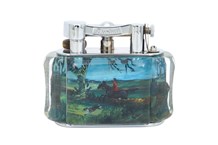SOTHEBY’S are to close Olympia as a saleroom and will move away from middle-range auctions to concentrate on the top end of the global art market. London sales will all take place at Bond Street with a minimum lot value of £3000. The announcement, buried in their year-end results, could prove to be the first tremor in a seismic chain reaction creating a whole new landscape in the world’s art market.
With Sotheby’s effectively dropping the high maintenance/low return middle market, Christie’s will have to decide whether to follow suit and also redirect their resources at the top end. The immediate reaction from some in the industry was that this would create a vacuum in the international auction market for middle-range goods, allowing Bonhams – the world’s number three auction house – and perhaps others to take over, especially in London.
Although Sotheby’s move is likely to cause shockwaves through the market, the company’s latest set of results explains why they have chosen this path. They have just enjoyed their best year ever, with revenues up nearly 30 per cent and operating profit soaring by 60 per cent. The rises have been driven by increased commissions, but those commissions have come, in large part, from the top end of the fine art market. Impressionist and Modern art has seen a hike of 79 per cent in auction sales to $932.4m in 2006. Contemporary art is up 61 per cent to $647m.
Then there are the emerging markets. Russian paintings and works of art brought $152.4m, an 80 per cent increase on the prior year, while sales in Asia totalled $284m, a 29 per cent rise. Contemporary Asian art brought $70.2m, 391 per cent up on the previous year.
If anything, the trend has become more marked. Just look at the figures for 2007 so far: February’s boom auctions of Contemporary, Modern and Impressionist art in London have contributed to a 60 per cent rise in UK year-to-date sales to $378m. In the US, the rise is 25 per cent. Interestingly, this puts UK sales so far for 2007 at considerably more than double those in the US by the end of February, a significant rise in the British market share on the same period in 2006.
Geography, the strong pound and stiff US regulations are persuading much of the emerging money, as well as markets, that London is a better place to do business than New York.
With such profits to be made, the top end of the market has become increasingly competitive. Guarantees, advance guarantees, a share of the buyer’s premium and elaborate marketing programmes are the weapons with which Christie’s and Sotheby’s fight it out to win key consignments. It is an ever more costly battle, but the spoils are huge.
And only last week, Christie’s parent company, Christie’s International, announced their intention to move seriously into the primary market for Contemp-orary art with the acquisition of London, European and New York gallery Haunch of Venison. They sell works by the likes of Rachel Whiteread, Gilbert and George and Andreas Gursky and show at Frieze, London’s autumn Contemporary art fair that ranks in the top three such events globally. Now Christie’s can gain access to such artists via the gallery, potentially buying or even commissioning works for sale direct.
With all this in mind, the profitable but unspectacular middle market sales held at Olympia and other salerooms round the world can’t compete, and Sotheby’s chief executive Bill Ruprecht has clearly decided that now is the time to up the stakes by effectively ditching them.
Acknowledging the ongoing importance of the top end of the market, he said: “We are making significant changes to our business, globally reorganising how we manage client relationships and, in the process, adding significant tools and staff in those areas our important clients value most.”
Technology will play a big part, as reported last week, with the launch of mySothebys, an online service allowing clients to create a bespoke personal web space for their dealings with the auction house.
As well as ending sales at Olympia, lower end sales will be cut in New York, Amsterdam and Milan. Staff numbers globally will be reduced by about five per cent, resulting in a first quarter charge of about $2m in severance costs.
At the same time, Sotheby’s will open offices in Moscow and Beijing and are strengthening their presence in the Middle East.
Relevant sales will be moved from Olympia to New Bond Street by the end of 2007, and Sotheby’s say that Olympia, on which they signed a new long-term lease late last year, will be retained as a support facility for their London operations.
Arrangements with companies selling in association with Sotheby’s, covering disciplines such as coins and medals, arms and armour, and fashion and textiles, have yet to be announced, but they are likely to be safe as they contribute to Sotheby’s bottom line without any significant input from the company.
Sotheby’s have shown their hand, but a word of warning: the middle market has always proved a reliable source of income when boom times are over.
Ivan Macquisten
Sotheby’s to close Olympia and ditch the middle market
Lure of top-end art proves too tempting




